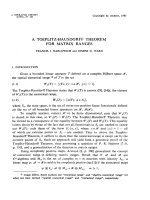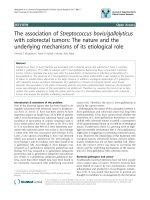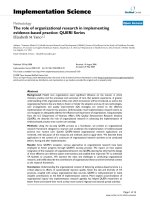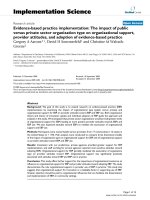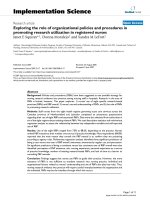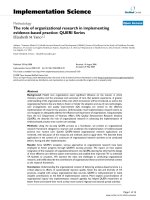Explaining turnover intention with organizational identification, perceived organizational support, protean career approach, and the mediating role of opganizational commitment a study of lecturers in viet nam
Bạn đang xem bản rút gọn của tài liệu. Xem và tải ngay bản đầy đủ của tài liệu tại đây (1.28 MB, 120 trang )
MINISTRY OF EDUCATION AND TRAINING
UNIVERSITY OF ECONOMICS, HO CHI MINH CITY
----------
Nguyễn Thị Hải Thúy
EXPLAINING TURNOVER INTENTION
WITH ORGANIZATIONAL IDENTIFICATION,
PERCEIVED ORGANIZATIONAL SUPPORT,
PROTEAN CAREER APPROACH AND THE MEDIATING
ROLE OF ORGANIZATIONAL COMMITMENT
MASTER THESIS
Ho Chi Minh City, 2012
MINISTRY OF EDUCATION AND TRAINING
UNIVERSITY OF ECONOMICS, HO CHI MINH CITY
----------
Nguyễn Thị Hải Thúy
EXPLAINING TURNOVER INTENTION
WITH ORGANIZATIONAL IDENTIFICATION,
PERCEIVED ORGANIZATIONAL SUPPORT,
PROTEAN CAREER APPROACH, AND THE MEDIATING
ROLE OF ORGANIZATIONAL COMMITMENT –
A STUDY OF LECTURERS IN VIET NAM
Major: Business Administration
Code: 60.34.01.02
MASTER THESIS
Supervisor: Dr. Phạm Quốc Hùng
Ho Chi Minh City, 2012
ACKNOWLEDGEMENT
I would like to express my deepest appreciation and gratitude to my
Supervisor, Dr. Pham Quoc Hung, a highly responsible and greatly respectable
scholar, who has given me much support, guidance, and encouragement throughout
my graduation study. This research study could not have been completed without
his surprising expertise, valuable insights, tactful guidance, timely constructive
feedback, and unbelievable attention to detail. Dr. Pham Quoc Hung has been a
wonderful model for me to follow as an advisor, scholar, and a human being. I
cannot thank him enough for always being there to contact, remind and motivate me
when I lost hope and strength.
I would like to offer my heart-felt thanks to Dr. Tran Ha Minh Quan, who
has been a whole-hearted and thoughtful watcher of my eMBA19, for his moral
support and timely encouragement at every stage of the study process.
I am deeply thankful and grateful to my parents-in-law, Le Van Ninh and
Nguyen Thi Kim Lien, for their ongoing support and encouragement, empathy and
sympathy to the completion of my graduation study. My master course could not
have been finished without their support and encouragement. They always help me
with the housework and childcare so that I could whole-heartedly invest in my
master course.
I would like to send my endless love and gratitude to my parents, Nguyen
Dang Dien and Tran Thi Dung, for their inspiration, reminder and even urge during
my life of study.
I am very fortunate to have my husband, a partner and also a friend, Le Viet
Hung, whose unconditional love kept me alive throughout my master study. His
love enriches my life beyond imagination. I truly thank him for his help with the
data collection and development of the survey.
Finally, I am extremely blessed to have my two daughter and son, Gato and
Fifa, to inspire me and give me a great perspective in life. It is their presence that
gives me the true understanding of my presence in life.
ABSTRACT
The primary purpose of the present study is to develop and test a model that
examines the turnover intention of lecturers through the influence of Organizational
Identification, Perceived Organizational Support, Protean Career Approach and the
mediating effect of Organizational Commitment. Based on the previous research
frameworks, the study tests positive or negative link of various factors on turnover
intention of lecturers. Moreover, the current study introduces a mediator –
Organizational Commitment – as a variable that plays an important role in
governing the relationships between the independent variables and the dependent
variable.
The data for the study was gathered from 300 currently employed lecturers in
Viet Nam. As hypothesized, the research model was proved to be reliable for further
testing. The results also indicate that these various factors all contribute to some
extent to turnover intention of lecturers. Especially, the mediator, Organizational
Commitment, was proved to significantly influence the relationships of
Organizational Identification – Turnover Intention, Perceived Organizational
Support – Turnover Intention, and Protean Career Approach – Turnover Intention.
Finally, the findings of the study are targeted at providing university
management an insight into the various factors that feed into lecturers’ turnover
intention with the hope that this can help them measure lecturers’ turnover intention
for better retention of this highly-qualified assets.
TABLE OF CONTENTS
List of Figures
List of Tables
List of Abbreviations
Chapter 1: Introduction ..........................................................................................1
1.1 Research background ...........................................................................................1
1.2 Research objective................................................................................................3
1.3 Scope and research methodology.........................................................................3
1.4 Structure of the research.......................................................................................4
Summary for Chapter 1
Chapter 2: Review of the literature .......................................................................6
2.1 Turnover Intention................................................................................................6
2.2 Organizational Identification................................................................................8
2.3 Perceived Organizational Support.......................................................................10
2.4 Protean Career Approach....................................................................................12
2.5 Organizational Commitment...............................................................................15
2.6 Organizational Identification and Turnover Intention........................................19
2.7 Perceived Organizational Support and Turnover Intention................................19
2.8 Protean Career Approach and Turnover Intention..............................................20
2.9 Organizational Commitment and Turnover Intention.........................................21
2.10 Organizational Identification and Organizational Commitment......................21
2.11 Perceived Organizational Support and Organizational Commitment..............22
2.12 Protean Career Approach and Organizational Commitment............................23
2.13 Hypothesized research model...........................................................................24
Summary for Chapter 2
Chapter 3: Methodology .......................................................................................27
3.1. Research design.................................................................................................27
3.2. Questionnaire development...............................................................................29
3.2.1 Turnover Intention...........................................................................................29
3.2.2 Organizational Identification...........................................................................29
3.2.3 Perceived Organizational Support...................................................................29
3.2.4 Protean Career Approach.................................................................................30
3.2.5 Organizational Commitment............................................................................30
3.3. Translation of the Questionnaire........................................................................32
3.4. The pilot study...................................................................................................34
3.5. Target population...............................................................................................35
3.6. Sample size .......................................................................................................36
3.7. Sample characteristics........................................................................................36
3.8. Selecting the sample and collecting data...........................................................37
3.9. Methods of data analysis....................................................................................38
3.9.1. Data screening................................................................................................38
3.9.2. Reliability........................................................................................................39
3.9.3. Confirmatory factor analysis..........................................................................40
3.9.4. Multiple regressions.......................................................................................43
3.9.5 Testing mediation relationship........................................................................45
Summary for Chapter 3
Chapter 4: Data Analysis ......................................................................................47
4.1 Data cleaning......................................................................................................47
4.2 Profiles of qualified respondents........................................................................47
4.3 Normality check.................................................................................................48
4.4 Reliability of the measurements.........................................................................48
4.5 Confirmatory factor analysis.............................................................................49
4.5.1 Confirmatory factor analysis for Organizational Identification, Perceived
Organizational
Support,
Protean
Career
Approach
and
Turnover
Intention....................................................................................................................49
4.5.2 Confirmatory factor analysis for Organizational Commitment ......................53
4.6 Correlation analysis............................................................................................57
4.7 Hypothesis testing...............................................................................................60
4.7.1 Effects of Organizational Identification, Perceived Organizational Support,
Protean Career Approach on Organizational Commitment (H1) .............................60
4.7.2 Effects of Organizational Identification, Perceived Organizational Support,
Protean Career Approach, Organizational Commitment on Turnover Intention (H2)
...................................................................................................................................62
4.7.3. The mediating effect of Organizational Commitment on Organizational
Identification – Turnover Intention, Perceived Organizational Support – Turnover
Intention, and Protean Career Approach – Turnover Intention relationships (H3)
...................................................................................................................................63
Summary of Chapter 4
Chapter 5: Discussion ............................................................................................71
5.1 Discussions of findings.......................................................................................71
5.2 Practical implications..........................................................................................77
5.3 Contribution of the current study........................................................................78
5.4 Limitations and Future research....................................................................,.....79
Summary of Chapter 5
REFERENCES
APPENDIX A: English & Vietnamese Questionnaire
APPENDIX B: Socio-Demographic Characteristics of the Qualified Samples.
APPENDIX C: Assessment of Normality
APPENDIX D: Reliability Test
APPENDIX E: Standardized Regression Weights & Squared Multiple Correlations
APPENDIX F: Multiple Regressions for Hypotheses Testing
LIST OF FIGURES
Figure
Description
Figure 2-1 The three components of Organizational Commitment
Page
18
(Affective, Continuance, Normative) based on Meyer & Allen
(1991)
Figure 2-2 Hypothesized Research Model
25
Figure 3-1 The research process
28
Figure 3-2 Mediating relationship
45
Figure 4-1 Hypothesized first-order 24-item CFA Model
51
Figure 4-2 Modified first-order 20-item CFA Model
52
Figure 4-3 Hypothesized first-order 18-item CFA Model
55
Figure 4-4 Modified first-order 11-item CFA Model
56
LIST OF TABLES
Table
Description
Page
Table 3-1
Description of Scales adopted in the study
33
Table 3-2
Demographic characteristic questions and range of responses
33
Table 3-3
Desired range of values for a good fit
41
Table 4-1
Summary of Cronbach Alpha measures across variables
49
Table 4-2
Assessing Fit Indices - Confirmatory factor analysis for
50
Organizational Identification, Perceived Organizational
Support, Protean Career Approach and Turnover Intention
Table 4-3
Assessing Fit Indices - Confirmatory factor analysis for
54
Organizational Commitment
Table 4-4
Correlation analysis
59
Table 4-5
Model Summary, ANOVA & Coefficients - The mediating
66
effect of Affective Commitment
Table 4-6
Model Summary, ANOVA & Coefficients - The mediating
68
effect of Normative Commitment
Table 5-1
Research Purposes, Hypotheses and Results
71
LIST OF ABBREVIATIONS
No.
Variables
Description
1
OI
Organizational Identification
2
POS
Perceived Organizational Support
3
PCA
Protean Career Approach
4
AC
Affective Commitment
5
CC
Continuance Commitment
6
NC
Normative Commitment
7
OC
Organizational Commitment
8
TIN
Turnover Intention
CHAPTER 1: INTRODUCTION
1.1 Research background
Employee turnover is a widely researched topic with a huge amount of
literature, and investigations into the causes of employee turnover are abundant.
One way to better understand employee turnover in organizations is therefore to
examine the various literature reviews that have appeared over time. However, a
careful reading of these reviews reveals that although much progress has been
made, much remains to be learned about the major causes of employee turnover and
models to turnover process.
The first formal reviews on this are the work of Brayfield and Crokket
(1955) and Herzberg et al. (1957), which both find evidence of a significant
relationship between employee dissatisfaction and subsequent turnover. Shortly
after this, March and Simon (1958) introduce (a) the perceived desirability of
leaving the organization and (b) the perceived ease of movement from the
organization, which largely affect turnover. Lefkowitz (1971) points to (a) the
employee‟s initial job expectations concerning the nature of the job; (b) job
satisfaction; (c) the physical work environment; (d) financial compensation; (e)
intrinsic aspects of the job; and (f) supervisory style and work-group dynamics as
influences on turnover. Porter and Steers (1973) argue that satisfaction modestly
related to turnover; major influences on turnover found in person, job, work
environment, and organization-wide factors, importance of met expectations. Price
(1977) examines various way in which turnover is defined and measured. He
concludes that turnover was influenced by dissatisfaction plus opportunity to leave.
He also considers organizational outcomes of turnover. Mobley et al. (1979)
concentrates on several variables in determining turnover which include age, tenure,
overall satisfaction, job content, intention to stay, and organizational commitment.
Mobley hypothesizes that dissatisfaction leads to thinking of quitting, intention to
search, intention to stay or leave, and finally, actual turnover.
1
Mowday, Porter and Steers (1982) suggest that an employee‟s intent to leave
can influence subsequent turnover in at least two ways. First, it may cause turnover
fairly directly, which means some people decide to leave their jobs even when
alternative jobs are not available. Second, an employee‟s intent to leave may
further influence actual turnover indirectly by causing the employee to initiate
search behavior for preferable alternative jobs. This is to emphasize that turnover
intention is an important step preceding actual turnover.
From the preceding discussion, clearly, no one can deny the fact that
employee turnover is of great importance to organizations. Job-quitting in the mid
of the course results in high costs in the recruitment and training of new staff.
Organizational productivity is also one of the challenges that arises from employee
turnover. In the case of universities, the cost of high turnover rate is even higher as
lecturers with knowledge and competence are the key assets and it affects the
academic and research activities of the universities. When lecturers quit their jobs in
the mid of semester, the consequence is very high as it is difficult for both the
university to arrange the substitute people and for students to accept new lecturers
in the mid of the course.
In the last decade, universities in Viet Nam have gone through many
fundamental changes. The Vietnamese government has invested much funds and
effort for the development of university education. As a result, the number of
universities (both public and non-public) in Viet Nam has increased dramatically in
recent years. The accession of Viet Nam into WTO in 2007 has also posed a big
challenge to Viet Nam university management since as of 1 January 2009, 100%
foreign-invested education entities are permitted (Working party on the accession of
Viet Nam, Schedule CLX – Viet Nam, Part II, 27 October 2006, 34). Qualified
lecturer‟s retention has become a challenge for University Management as
competition has become harsher.
Are Vietnamese lecturers loyal and committed to their work? What are the
various factors that may influence their turnover intentions? What inferences can be
2
made from the study that can be utilized to reduce attrition among Vietnamese
lecturers? The present study will review the literature related to the framework of
the study, the methodology utilized for data analysis and discussion of
recommendations.
1.2 Research objectives
The purpose of this thesis is to find out the intentions of lecturers to quit a
job in universities. More specifically, it is targeted at measuring the influence of
various factors (including Organizational Identification, Perceived Organizational
Support, Protean Career Approach) on their turnover intentions. It also aims at
finding out the mediating role of Organizational Commitment that contributes to the
intentions of lecturers. The effort is made to help university management in the
retention of their qualified lecturers.
The study is targeted at addressing the following questions:
Question 1: How do Organizational Identification, Perceived Organizational
Support and Protean Career Approach affect Affective Commitment, Continuance
Commitment and Normative Commitment?
Question 2: How do Organizational Identification, Perceived Organizational
Support, Protean Career Approach, Affective Commitment, Continuance Commitment
and Normative Commitment influence Turnover Intention.?
Question 3: How do Affective Commitment, Continuance Commitment and
Normative Commitment mediate Organizational Identification – Turnover
Intention, Perceived Organizational Support – Turnover Intention and Protean
Career Approach - Turnover Intention relationships?
1.3 Scope and research methodology
The survey is carried out in Ho Chi Minh City, aiming at the following
universities: Foreign Trade University, HCMC Branch, Ho Chi Minh University of
Industry, Ho Chi Minh University of Technology, Hong Bang International
University, TonDucThang University. Qualified respondents for the present study
3
are lecturers who are currently employed by a specific university, not visiting
lecturers.
Based on the literature review compiled, a set of variables are determined.
The use of a quantitative survey in which appropriate sampling procedure is carried
out allows the researcher to make inferences about turnover intention of lecturers.
The pilot study is done to modify the questionnaire into a clearer and more
understandable one for respondents. After completion, the questionnaires are
distributed personally to 300 lecturers. The SPSS 16 for Window, Amos 16 and
Excel are chosen for data processing and analysis. Cronbach alpha is used to
measure internal reliability. Confirmatory Factor Analysis is designed to confirm
the hypothesized model.
1.4 Structure of the research
The present thesis is organized in five chapters. Chapter 1 is concerned with
the introduction of the thesis which includes research background, research
objectives, scope and research methodology. Chapter 2 reviews the literature that
deals with the various factors in the previous studies. Specifically, the thesis
focused on the five factors: Turnover Intention, Organizational Identification,
Perceived Organizational Support, Protean Career Approach, and Organizational
Commitment. The hypotheses are proposed based on the literature review given.
Chapter three provides theoretical framework for the research design and
methodology followed by results and discussion presented in Chapter four. Based
on the number and figures analyzed in the previous chapter, recommendations are
therefore made in Chapter five. This final chapter presents the major findings of the
research, managerial implication as well as recommendations.
SUMMARY OF CHAPTER ONE
No country can stand on their own feet without education. No university can
make their success without their lecturers. Lecturers are not only the vital asset for
the existence and development of one university but also the key factor for the
4
prosperity of one country. Good retention and development of them pave the way
for the university‟s success and the country‟s thrive in the future.
Chapter 1 introduces the research background for the present thesis.
Research objectives, methodology, thesis scope and structure are also given, which
gives the readers an overview of the theoretical and practical framework of the
thesis. Research questions raised lays out the roadmap for further analysis and
discussion in the forthcoming chapters. All questions seek to confirm the significant
relationships between Organizational Identification, Perceived Organizational
Support, Protean Career Approach and Turnover Intention, the mediation role of
Organizational Commitment on the mentioned relationships among the target
respondents of lecturers.
5
CHAPTER 2: REVIEW OF THE LITERATURE
The retention of professional and qualified lecturers has become a challenge
for university management in recent years. In this paper, an effort has been made to
find out and understand various factors that lead lecturers toward their turnover
intentions.
According to Loquercio (2006), people hardly leave their jobs in which they
feel happy and satisfied, even when they are offered higher pay elsewhere.
Sometimes lecturers are 'pushed' due to their dissatisfaction in their present jobs to
seek new chances or „pulled‟ by other competitors due to the better conditions
(Iqtidar Ali Shah et al., 2010). Or simply they leave because of their personal
factors. On the basis of available literature, the various factors in the present study
include Turnover Intention, Organizational Identification, Perceived Organizational
Support, Protean Career Approach and Organizational Commitment.
Chapter 2 defines and discusses the key variables in the hypothesized
models. The chapter is structured in the format of the conceptualization of each
variable, concluding remarks after each conceptualization and
their effect on
Turnover Intention and Organizational Commitment. The theoretical framework is
introduced to explain possible outcomes associated with turnover intention.
2.1 Turnover Intention
2.1.1 Conceptualization of Turnover Intention
Turnover intentions, or intentions to quit a job, have been found to be one of
the best predictors of actual quitting (Griffeth et al., 2001). In a study by Mobley et
al., (1977), it is presented in the withdrawal decision process that thinking of
quitting a job is the next logical step after experiencing dissatisfaction and that is
called “intention to leave”. According to Wanous (1979), the reason for job quitting
is originated from both the employees and the employer and is categorized as either
voluntary or involuntary. Under this research, voluntary turnover is chosen for
discussion, and turnover intentions, not actual turnover, will be the dependent
variable.
6
Krausz et al. (1995) argue that studies using intentions as the criterion have
several advantages over those using behavior as the dependent variable. Firstly,
behaviors are often influenced by many variables (e.g., company policies, economic
conditions, etc) that cannot be controlled by the investigator but influence the
findings. Secondly, turnover research has shown that a person‟s self-expressed
intentions are the best predictor of actual turnover (Steel and Ovalle, 1984).
Therefore, turnover intentions should be used as the dependent variable for the
present study.
Jenner and Taylor (2000) categorize voluntary turnover in the following four
ways:
- Outside factors: An employee leaves an organization for reasons unrelated
to work, such as illness, moving out of town, or aspiring to other goals;
- Functional turnover: Both employee and employer are willing to accept
this kind of turnover. For example, someone may feel uncomfortable with an
organizational culture and have poor performance;
- Push factors: Employee is dissatisfied with work or the organizational
leadership style, leading to unwanted turnover for the employer, because this
employee may have outstanding performance; and
- Pull of rivals: Competitors have better conditions to attract employees to
leave organization.
Braham (2005) proposes seven hidden reasons that make employees leave an
organization:
- Job duties or workplace conditions were not as anticipated;
- There was a mismatch between job and person;
- Too little coaching and feedback were provided;
- There were too few growth and advancement opportunities;
- The employee felt devalued and unrecognized ;
- The employee experienced stress from overwork and work-life imbalance;
- There was a loss of confidence in senior management.
7
2.1.2 Concluding remarks on Turnover Intention
Based on the preceding discussion, several concluding remarks can be made.
To begin with, it should be noted that voluntary turnover should be chosen for the
analysis under the present study. Second, the thesis tries to find out different factors
that feed into turnover intention, not actual turnover. And finally, there are many
different factors or reasons that contribute to turnover intentions from the literature.
2.2 Organizational Identification
2.2.1 Conceptualization of Organizational Identification
Social identities are popular in life as people often define themselves in
terms of certain group memberships. To be a member of a sports club or a musical
association are examples of identification with a group. People often see themselves
as a part of a country, gender, race, political movement, sports team or organization
and then, these groups depend on their members to survive (Fisher and Wakefield,
1998).
Organizational identification is a specific form of group identification. It can
be described as a way to explain the relationship between employees and the
organization they work for. Organizational identification is defined as „the
perception of oneness with or belongingness to an organization, where the
individual defines him or herself in terms of the organization(s) of which he or she
is a member‟ (Mael and Ashforth, 1992, p. 104).
Foote (1951) is one of the first people who uses the term “identification” in
an organizational context. Foote describes Organizational Identification as
„appropriation of and commitment to a particular identity or series of identities‟ (p.
17). It can be seen from his view that Organizational Identification reassures an
individual as a member of the organization and motivates him or her to act on
behalf of the organization. Therefore it can be concluded that Foote uses selfconception as part of the definition of Organizational Identification and he
emphasizes identification as a basis for motivation.
8
Later on, several other authors try to build the concept of organizational
identification. Brown (1969) focuses on four aspects of involvement including
attraction to the organization, consistency of organizational and individual goals,
loyalty toward the organization and reference of self to organizational membership.
Lee (1971) defines organizational identification as „the degree of the
individual‟s broad personal identification with the organization‟ (p. 215). His
approach on Organizational Identification emphasizes three main aspects. Firstly, it
describes a sense of belongingness which results from common goals shared with
others. A second feature in this definition is loyalty. Finally, shared characteristics
between the individual and others within the organization imply a certain similarity.
Like Brown (1969), Lee uses the term loyalty as a part of the definition of
Organizational Identification. Lee‟s definition seems to be more distinguishable
from other related constructs than Browns‟. Using terms of sense of belongingness,
loyalty and shared characteristics gives us a broad conceptualization of
Organization Identification.
Later in 1970, Hall, Schneider and Nygren define organizational
identification as „the process by which the goals of the organization and those of the
individual become increasingly integrated or congruent‟ (Hall et al., 1970, p. 176–
177). It can be clarified from the definition that over the time of working,
employee‟s goals become identical to those of organization.
A different conceptualization of organizational identification is introduced
by Cheney (1983) and developed further by Cheney and Tompkins (1987).
Cheney‟s (1983) defines organizational identification as „an active process by
which individuals link themselves to elements in the social scene‟ (Cheney, 1983, p.
342).
Then, in 1986, O‟Reilly and Chatman (1986) define identification as the
process of “an individual accepting influence from a group (organization) in order
to establish and maintain a relationship”.
2.2.2 Concluding remarks on Organizational Identification
9
Each approach has its own emphasis. In general, they have a common point
in the identification of one „self‟ with the organization. However, it seems that the
approaches mentioned above include different psychological states of individuals.
In turn, this makes it difficult to define organizational identification as a unique
construct.
Although differences are clear, all definitions described above show some
kind of overlap. The main similarity is the linkage between the self and the
organization and the definition of oneself in terms of the characteristics of the
organization. Furthermore, for the individual, identification means that elements of
the organizational characteristics to some extent become part of their own selfconcept.
Despite the strong overlap between several conceptualizations, some appear
to be more suitable than others. On the one hand, several approaches describe more
than just identification (e.g. involvement, loyalty, behavioral outcomes of
identification). This causes problems for the differentiation of determinants of
organizational identification. On the other hand, some scholars choose a rather
narrow definition of Organizational Identification, by focusing only on the cognitive
aspects (knowing) of identification.
The aim of this thesis is not to question the concept of organizational
identification itself or come up with a new definition. In this study, Mael and
Ashforth‟s approach on identification is used. However, there is strong
contradiction between the measurement and their own definition. Mael and
Ashforth state that identification is a cognitive process (Mael and Ashforth, 1992, p.
105), whereas their measurement instrument also contains emotional aspects. For
example, respondents have to answer whether they have feelings of embarrassment
or feel insulted when their organization is criticized. This seems to refer to their
emotional states.
2.3 Perceived Organizational Support
2.3.1 Conceptualization of Perceived Organizational Support
10
Employees are usually practical. They are generally interested in whether
management is ready to make changes in favor of their benefits and working
conditions. They regard the organization as a source of socio-emotional resources
such as respect and care, tangible benefits such as salaries and medical benefits, etc.
The high evaluation by the organization indicates that the employees are noted and
rewarded.
Organizational support is conceptualized as an environment in which the
needs of the employees are of the same importance as the goals of profit
(Cropanzano, Kacmar, and Bozemen, 1995). It is viewed as the perception that the
organization cares about and values individuals within the organization (Howes,
Citera, and Cropanzano, 1995). Organizational support is also seen as employer
commitment to the employee (Shore & Shore, 1995). Therefore, this type of
environment naturally leads to the increase in employee commitment to the
organization.
Perception is an important aspect of organizational support. An individual
may perceive whether his or her work environment is supportive or not. This
explains the reason why there is the concept of Perceived Organizational Support.
Perceived Organizational Support is the degree to which employees believe that
their organization values their contributions and cares about their well-being
(Eisenberger, Huntington, Huntington, & Sowa, 1986; Rhoades &Eisenberger,
2002).
The treatment by the organization toward its employees influences Perceived
Organizational Support and in turn, it affects the employee‟s interpretation of the
organization‟s motives and commitment. It can be implied that the employees
expect a degree of support from the organization in a wide variety of situations.
Examples may include how the organization reacts when the employees have
illnesses, mistakes, and whether the organization is willing to pay a fair salary and
intend to make the employee‟s job more meaningful and interesting.
11
However, it should be noted that the favorable treatments provided by the
organization must be perceived as voluntary by the employees. Only in this case,
employees‟ Perceived Organizational Support is positively associated with the
organization‟s treatment. Let‟s take an example. Workers may receive better wages
and benefits. However, if these benefits result from a long period of difficult
negotiations and battles, they will be considered as involuntarily provided, and
therefore, the benefits will have little influence on Perceived Organizational
Support. This suggests that organizations should not automatically come to a
conclusion that well-treated employees will have high Perceived Organizational
Support. Rhoades and Eisenberger (2002) found that opportunities for greater
recognition, pay, and promotion are positively associated with Perceived
Organizational Support.
2.3.2 Concluding remarks on Perceived Organizational Support
Perceived organizational support is an important factor in how an employee
feels about the organization that he or she belongs to. It is the extent to which an
employee perceives how the organization cares about and values its employees. In
this thesis, the approach of Eisenberger, Huntington, Hutchison, and Sowa is
chosen.
Organizational support theory (Eisenberger, Huntington, Hutchinson, &
Sowa, 1986; Rhoades &Eisenberger, 2002; Shore & Shore, 1995) maintains that
employees form a general perception and expectancy concerning the evaluation by
the organization of their contributions and its cares about their well-being. Such
perceived organizational support will increase employees‟ willingness and readiness
to help the organization reach its objectives and their affective commitment to the
organization.
2.4 Protean Career Approach
2.4.1 Conceptualization of Protean Career Approach
As organizations are facing the current highly volatile and unstable
environment, they must adapt themselves to be smarter and swifter enough to
12
market conditions to exist. Similarly, employees must be equally flexible and
adaptive. This new orientation has been termed the “Protean Career Approach”.
Under the new approach, the psychological contract between employer and
employee no longer means a guarantee of lifetime employment and steady career
advancement (e.g. Arthur & Rousseau, 1996) since in response to fast-moving
globalization, competitive pressures and rapid technological advance, companies
must be smart enough to exist. It can be implied that individuals must take active
role to create career options that allow them to realize their personal career goals
and ensure their employability (Hall & Moss, 1998). New career patterns are
therefore emerged for an individual to capture the new changing nature of careers,
which emphasizes self-direction and values-driven predispositions (Briscoe, Hall, &
DeMuth, 2006).
Protean career is first introduced by Hall in 1976. He defines this orientation
as follows: „The protean career is a process which the person, not the organization,
is managing. It consists of all of the person's varied experiences in education,
training, work in several organizations, changes in occupational field, etc. The
protean person's own personal career choices and search for self-fulfillment are the
unifying or integrative elements in his or her life. The criterion of success is internal
(psychological success), not external.‟ (Hall, 1976, p. 201).
Baruch (2004: 71) described the protean career as: “a contract with oneself,
rather than with the organization” since individuals “take responsibility for
transforming their career path, in taking responsibility for their career”. Hall (2004)
and Hall and Chandler (2005) propose hallmarks of a protean orientation including
freedom and growth, professional commitment, and the attainment of psychological
success.
Later then, Hall and his colleagues (Hall, 1986; Hall, 2002; Hall & Moss,
1998) introduce
two career "metacompetencies" including identity or self-
awareness and adaptability under the protean career approach. It is better for
13
employees to develop their self-awareness and adaptability since as they will equip
the employees to learn from their experience and develop themselves.
Then, in 2006, Briscoe, Hall, and DeMuth identify two protean-career
attitudes: self-directed career attitudes and values-driven predispositions. An
individual with self-directed attitudes are independent in managing his or her
vocational behavior, while a values-driven individual bases on their own values
rather than the organization‟s values to guide their career when making career
choices.
The core values of protean career approach include freedom and growth,
high mobility, and subjective success criteria (psychological success) vs. objective
one (e.g. position, salary). Psychological success means that an individual reaches
his or her success which are highly valued because they are measured according to
his own goals, not externally defined goals.
2.4.2 Concluding remarks on Protean Career Approach
Hall first introduces the term „protean career‟ in 1976 as a process in which
employees manage their own career path and take responsibility for their career.
After that, he and his colleagues find out the two career metacompetencies
including identity and adaptability to emphasize employee‟s own development at
the workplace by developing these two meatcompetencies. A more complicated
protean orientation is developed by Hall (2004) and Hall and Chandler (2005)
including more components which are freedom and growth, professional
commitment, and the attainment of psychological success and the discovery of a
“calling”.
It can be seen from the above-mentioned definitions that protean career is an
approach where an individual takes charge of their career path rather than the
organization. Those who have protean career approach highly value growth and
freedom. They define career success in terms of psychological criteria with
examples of job satisfaction, self-actualization, personal accomplishment and a
feeling of fulfillment (Hall & Chandler, 2005; Hall & Mirvis, 1996). This approach
14
is in basic contrast with traditional view in which career success is defined in terms
of external criteria such as promotion, salary and occupational status.
From Hall and his colleague‟s arguments, it can be concluded that protean
careerists
are more intrinsically motivated since they find opportunities to
challenge themselves. Individuals who have a more traditional career attitude tend
to be passive in managing their career while individuals with a protean career
attitude take more active role in making their career choices and finding
opportunities (Hall, 1976, 2002). In this thesis, the approach introduced by Hall
(2006) is chosen for further analysis.
2.5 Organizational Commitment
2.5.1 Conceptualization of Organizational Commitment
Organizational commitment is defined as the extent to which an individual
accepts, internalizes and views his or her role based on organizational values and
goals (Jan, 1989). An individual becomes committed to an organization when (a)
they internalize the goals and values of the organization, (b) they are willing to exert
their best effort to reach the organization‟s goals, and (c) they have a strong desire
to remain in the organization (Hunt & Morgan, 1994; Jan, 1989; Mowday, Steers, &
Porter, 1982).
The initial model of organizational commitment is developed by Porter,
Steers, Mowday, and Boulian (1974).
They construct the model based on an
employee‟s attachment to the organization. Under the conceptualization developed
by Porter and associates (1974), two factors are mentioned: attitudinal commitment
and behavioral commitment (Mowday, et al., 1982). However, Mayer and
Schoorman (1998) consider this conceptualization as a „uni-dimensional construct‟
and they argue that it does not fully explain the process of commitment or how an
employee becomes committed to an organization.
Later then, in 1994 Hunt and Morgan emphasizes that commitment should be
measured under a multidimensional construct. The multidimensional construct starts
with a two-dimensional model of organizational commitment introduced by several
15

